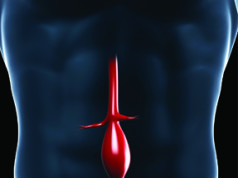 A recent study concludes that the interplay of anatomical and physiological factors in patients with complex aneurysms renders conventional risk stratification tools “unhelpful”, and that a multidisciplinary approach to assessment is mandated. Furthermore, the investigators suggest it is “unusual” that a single major factor ultimately determines treatment modality.
A recent study concludes that the interplay of anatomical and physiological factors in patients with complex aneurysms renders conventional risk stratification tools “unhelpful”, and that a multidisciplinary approach to assessment is mandated. Furthermore, the investigators suggest it is “unusual” that a single major factor ultimately determines treatment modality.
Benjamin Patterson presented the results at the British Society of Endovascular Therapy 2019 Annual Meeting (BSET; 27–28 June, Wotton-under-Edge, UK), on behalf of Michael Jenkins and colleagues at the Imperial Vascular Unit, London, UK. The investigators describe that the interplay of morphology and physiology is “complex” and that these interactions “defy the creation of a standardised algorithm”. They explain that assessment is a continuous process of weighing many factors, and is often based on clinical judgement, concluding that physicians should aim for the “least risky, most durable solution possible”.
At the BSET meeting, Patterson discussed why this topic is important, noting that European guidelines recommend avoiding bias toward a certain treatment modality, and that the UK-based National Institute for Health and Care Excellence (NICE) draft guidelines use “fitness” to determine treatment, suggesting that open repair should be carried out if the patient is “fit”, and no repair should be carried out if the patient is “unfit”, however there is “no validated way to stratify fitness,” remarked Patterson. He suggested that aortic networks should provide all options.
While endovascular repair has been increasingly adopted in the treatment of complex aneurysms where previously only open repair was available, the investigators of this study sought to define factors that determine the modality of treatment employed using a retrospective cohort study, conducted at the investigators’ centre, using data from the year 2018–2019.
Patterson and colleagues identified consecutive patients operated on for suprarenal aortic aneurysms and thoracoabdominal aortic aneurysms in the specified time period. Physiological and anatomical data were collected from electronic clinical records and correspondence, and the primary reason for the modality of treatment selected was established. The Chi-squared test was used to examine differences between groups.
The investigators remark that there are four main factors governing the selection of treatment modality for complex aneurysms—physiology, morphology, urgency, and patient choice. In this patient cohort, across types I–IV thoracoabdominal aortic aneurysms and juxtarenal/suprarenal aortic aneurysms, physiology was the main reason for treatment modality selection, followed by morphology and then urgency. They note that patient choice was never a primary reason for modality in this cohort.
Despite patients in the open and endovascular groups being of similar average age (71 and 73 years, respectively), open repair patients were more likely to have a good exercise tolerance, good pulmonary function, and less likely to have had previous abdominal surgery. Cardiac and renal status was similar in both groups, and anatomical and physiological reasons were equally cited as reasons for choosing treatment modality when the open and endovascular groups were compared.
Of 136 complex aneurysms, 82 were operated on, of which 59 were I–IV or J/SRAA. Five patients were turned down for repair by clinicans, three due to patient choice, 14 were awaiting repair, and two died waiting for repair.
On the type of surgery conduction, Patterson commented: “For extensive aneurysms, such as type I and type II thoracoabdominal aneurysms patients were much more likely to receive an endovascular treatment because of the extent of surgery required and the fact that they would be more likely to be rejected for surgery based on certain physiological parameters. In the type III group, there is more of an even split. This is explained by the fact that the type III group happen to be slightly fitter than the type I and type II group, which might be a function of the fact that patients with more extensive aneurysms have more extensive disease. If we look at the type IV thoracoabdominal aneurysms we can see that the majority were repaired open, and, looking at the notes for these patients, we can see that a lot of these have been turned down locally for endovascular treatment and had to be sent to our Vascular Unit at Imperial.”
Regarding the relatively small study cohort, Patterson outlined the benefits of the chosen sample size for this particular study: “If you look on a big data level, then what you miss is the complexities invovled, and you miss the constant and often subtle weighing up process between factors during the decision making process”.













